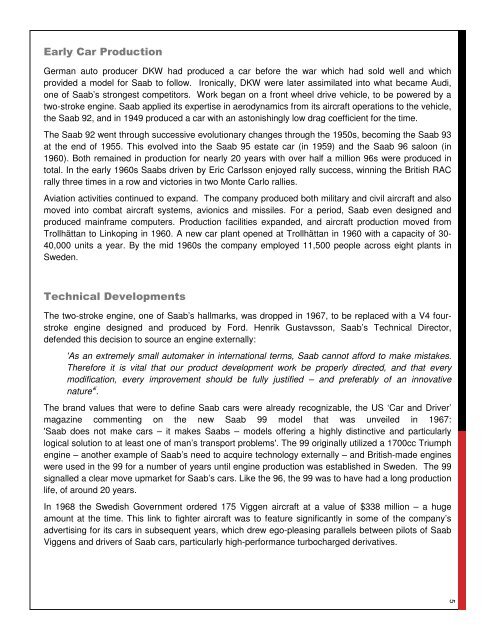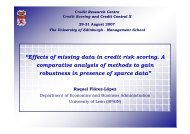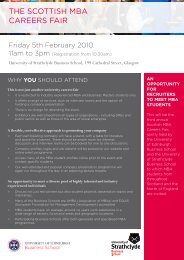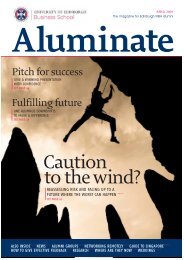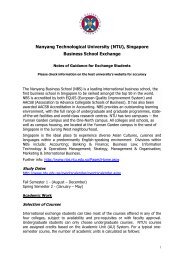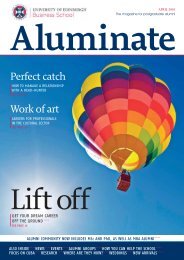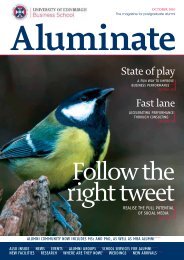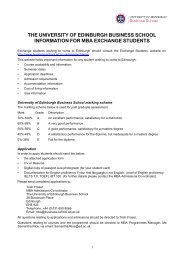killed Saab Automobile? - Business School - University of Edinburgh
killed Saab Automobile? - Business School - University of Edinburgh
killed Saab Automobile? - Business School - University of Edinburgh
You also want an ePaper? Increase the reach of your titles
YUMPU automatically turns print PDFs into web optimized ePapers that Google loves.
Early Car Production<br />
German auto producer DKW had produced a car before the war which had sold well and which<br />
provided a model for <strong>Saab</strong> to follow. Ironically, DKW were later assimilated into what became Audi,<br />
one <strong>of</strong> <strong>Saab</strong>’s strongest competitors. Work began on a front wheel drive vehicle, to be powered by a<br />
two-stroke engine. <strong>Saab</strong> applied its expertise in aerodynamics from its aircraft operations to the vehicle,<br />
the <strong>Saab</strong> 92, and in 1949 produced a car with an astonishingly low drag coefficient for the time.<br />
The <strong>Saab</strong> 92 went through successive evolutionary changes through the 1950s, becoming the <strong>Saab</strong> 93<br />
at the end <strong>of</strong> 1955. This evolved into the <strong>Saab</strong> 95 estate car (in 1959) and the <strong>Saab</strong> 96 saloon (in<br />
1960). Both remained in production for nearly 20 years with over half a million 96s were produced in<br />
total. In the early 1960s <strong>Saab</strong>s driven by Eric Carlsson enjoyed rally success, winning the British RAC<br />
rally three times in a row and victories in two Monte Carlo rallies.<br />
Aviation activities continued to expand. The company produced both military and civil aircraft and also<br />
moved into combat aircraft systems, avionics and missiles. For a period, <strong>Saab</strong> even designed and<br />
produced mainframe computers. Production facilities expanded, and aircraft production moved from<br />
Trollhättan to Linkoping in 1960. A new car plant opened at Trollhättan in 1960 with a capacity <strong>of</strong> 30-<br />
40,000 units a year. By the mid 1960s the company employed 11,500 people across eight plants in<br />
Sweden.<br />
Technical Developments<br />
The two-stroke engine, one <strong>of</strong> <strong>Saab</strong>’s hallmarks, was dropped in 1967, to be replaced with a V4 fourstroke<br />
engine designed and produced by Ford. Henrik Gustavsson, <strong>Saab</strong>’s Technical Director,<br />
defended this decision to source an engine externally:<br />
'As an extremely small automaker in international terms, <strong>Saab</strong> cannot afford to make mistakes.<br />
Therefore it is vital that our product development work be properly directed, and that every<br />
modification, every improvement should be fully justified – and preferably <strong>of</strong> an innovative<br />
nature' ii .<br />
The brand values that were to define <strong>Saab</strong> cars were already recognizable, the US ‘Car and Driver’<br />
magazine commenting on the new <strong>Saab</strong> 99 model that was unveiled in 1967:<br />
'<strong>Saab</strong> does not make cars – it makes <strong>Saab</strong>s – models <strong>of</strong>fering a highly distinctive and particularly<br />
logical solution to at least one <strong>of</strong> man’s transport problems'. The 99 originally utilized a 1700cc Triumph<br />
engine – another example <strong>of</strong> <strong>Saab</strong>’s need to acquire technology externally – and British-made engines<br />
were used in the 99 for a number <strong>of</strong> years until engine production was established in Sweden. The 99<br />
signalled a clear move upmarket for <strong>Saab</strong>’s cars. Like the 96, the 99 was to have had a long production<br />
life, <strong>of</strong> around 20 years.<br />
In 1968 the Swedish Government ordered 175 Viggen aircraft at a value <strong>of</strong> $338 million – a huge<br />
amount at the time. This link to fighter aircraft was to feature significantly in some <strong>of</strong> the company’s<br />
advertising for its cars in subsequent years, which drew ego-pleasing parallels between pilots <strong>of</strong> <strong>Saab</strong><br />
Viggens and drivers <strong>of</strong> <strong>Saab</strong> cars, particularly high-performance turbocharged derivatives.<br />
5


